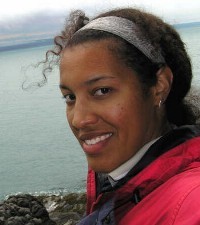Tamara Moss

B.Sc. (Honours) Thesis
Comparison of Late Holocene Oceanographic and Sedimentologic Records from the Amundsen Gulf, Northwest Territories
(PDF - 13.85 Mb)
Analysis of sediments was performed on two box cores collected as part of the Canadian Arctic Shelf Exchange Study (CASES). The two stations examined (stations 403B (59 m) and 415B (56 m)) are located in the Amundsen Gulf. The study was undertaken in order to develop a record of changes in the sedimentologic and oceanographic history of the area. Arctic benthic foraminiferal assemblages of the Late Holocene (403B) and Pleistocene (415B) have contrasting sedimentation rates. Core 403B is from an area of high sedimentation from on the Beaufort Shelf, where the Mackenzie River outputs sediments. Core 415B is from an area of low sedimentation on the steep slope of Banks Island, and lacks sediment input form a large river system. Core 415B is from a location that has drumlin-like features and ice-scouring, which are revealed with multibeam sonar. By comparing and contrasting 403B and 415B, a broader interpretation of the natural history of the Amundsen Gulf is revealed. Foraminifera >63 ? from 403B revealed that this is a shelf environment abundant in Cassidulina reniforme, Islandiella teretis, Spiroplectammina biformis, and Elphidium spp., with an interval barren in foraminifera, except for a rare assemblage of Reophax spp. The most abundant foraminifera >45-63 ? from 403B were Bolivina arctica, Texturlaria earlandi, Reophax scotti and Egerella advena. There were more foraminifera > 63 ? than >45-63 ?. Foraminifera >63 ? from 415B revealed that this was once a Pleistoce shoreline abundant in Bolivina arctica, as well as Spiroplectammina biformis and Reophax arctica. The environment gradually became a shelf environment abundant in Spiroplectammina biformis, Textularia earlandi, and Trochammina globigerinformis. The most abundant foraminifera >45-63 ? from 415B were Bolivina arctica, Textularia earlandi, and Spiroplectammina bioformis. There were significantly more foraminifera >63 ? than >45-63 ?. More individuals were found in 415B than in 403B, and the species diversity was slightly higher in 415B than in 403B. Core 403B represents approximately the last 350 years of a shelf environment with an interval barren in foraminifera. This barren zone could be due to carbonate dissolution. When trying to find similar past environments such as this one, only deep-water environments seem to match. Core 415B is a progressively deep environment, which starts as a Pleistocene shoreline and becomes deeper with the abundance of deep-water species and shelf species. Both cores seem to show that they have been influenced by either Arctic Surface Water or Arctic Intermediate Water in their natural history. This study will contribute to the assessment of factors that presently influence sea ice cover, a key element of the Arctic ecosystem.
Keywords:
Pages: 85
Supervisors: David Scott



